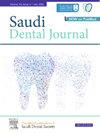错牙合特征作为年轻人抑郁症的危险指标:一项基于人群的横断面研究
IF 2.3
Q3 DENTISTRY, ORAL SURGERY & MEDICINE
引用次数: 0
摘要
虽然错牙合历来因其对颅面发育、口腔功能和美学的影响而受到关注,但最近的研究已经开始调查错牙合与整体健康(如心理健康)的其他方面之间可能存在的联系。目的本研究旨在分析年轻人各种牙错的特征及其与抑郁症状的潜在关系。数据的获取采用了国家健康和营养检查调查。方法本横断面研究采用具有全国代表性的人口样本,包括1988年至1994年在全国健康和营养检查调查III下接受调查的3,806名参与者的数据。纳入标准为:完成错牙合特征的临床评估,有牙齿,无既往或当前正畸治疗史,无牙痛,并回答精神状态问卷。考虑到调查的复杂抽样设计性质,统计评估涉及逻辑回归模型和卡方检验。结果经校正后的logistic回归模型显示,错颌畸形特征与重度抑郁发作(MDEs)之间无显著相关性。相反,同样的模型在原始和调整的分析中都揭示了错颌特征(特别是高拥挤和两个或多个累积错颌特征)与心境恶劣之间的正相关。结论特定错颌特征与心境恶劣相关,而与MDEs无关。这些发现表明错牙合和抑郁症之间的关系是复杂和多方面的。本文章由计算机程序翻译,如有差异,请以英文原文为准。
Malocclusion traits as risk indicators for depression in young adults: A population-based cross-sectional study
Background
Although malocclusion has historically drawn attention for its effects on craniofacial development, oral function, and aesthetics, recent studies have started to investigate the possible association between malocclusion and other aspects of overall health, such as mental health.
Objectives
This study aimed to analyze various dental malocclusion characteristics and their potential association with depressive symptoms among young adults. The National Health and Nutrition Examination Survey was used for data procurement.
Methods
This cross-sectional study was conducted using a nationally representative population sample, including data from 3,806 participants surveyed between 1988 and 1994 under the National Health and Nutrition Examination Survey III. The inclusion criteria were completion of the clinical assessment for malocclusion traits, being dentate, reporting no history of previous or current orthodontic treatment, reporting no dental pain, and responding to a questionnaire about psychiatric status. Statistical evaluations involved logistic regression modeling and chi-squared tests, considering the complex sampling design nature of the survey.
Results
Crude and adjusted logistic regression models indicated no significant association between malocclusion traits and major depressive episodes (MDEs). Conversely, the same models revealed a positive association between malocclusion traits (specifically, upper crowding and two or more cumulative malocclusion traits) and dysthymia in both crude and adjusted analyses.
Conclusion
Specific malocclusion traits were associated with dysthymia, whereas no such associations existed with MDEs. These findings suggest that the association between malocclusion and depression is complex and multifaceted.
求助全文
通过发布文献求助,成功后即可免费获取论文全文。
去求助
来源期刊

Saudi Dental Journal
DENTISTRY, ORAL SURGERY & MEDICINE-
CiteScore
3.60
自引率
0.00%
发文量
86
审稿时长
22 weeks
期刊介绍:
Saudi Dental Journal is an English language, peer-reviewed scholarly publication in the area of dentistry. Saudi Dental Journal publishes original research and reviews on, but not limited to: • dental disease • clinical trials • dental equipment • new and experimental techniques • epidemiology and oral health • restorative dentistry • periodontology • endodontology • prosthodontics • paediatric dentistry • orthodontics and dental education Saudi Dental Journal is the official publication of the Saudi Dental Society and is published by King Saud University in collaboration with Elsevier and is edited by an international group of eminent researchers.
 求助内容:
求助内容: 应助结果提醒方式:
应助结果提醒方式:


